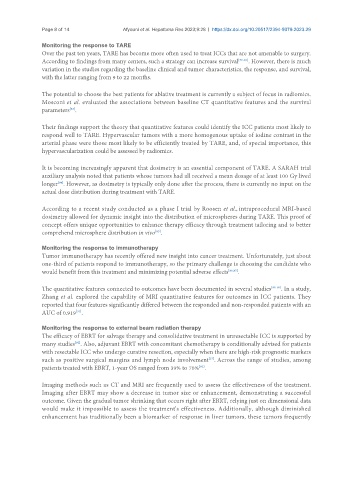Page 39 - Read Online
P. 39
Page 8 of 14 Afyouni et al. Hepatoma Res 2023;9:28 https://dx.doi.org/10.20517/2394-5079.2023.29
Monitoring the response to TARE
Over the past ten years, TARE has become more often used to treat ICCs that are not amenable to surgery.
According to findings from many centers, such a strategy can increase survival [79-82] . However, there is much
variation in the studies regarding the baseline clinical and tumor characteristics, the response, and survival,
with the latter ranging from 9 to 22 months.
The potential to choose the best patients for ablative treatment is currently a subject of focus in radiomics.
Mosconi et al. evaluated the associations between baseline CT quantitative features and the survival
[83]
parameters .
Their findings support the theory that quantitative features could identify the ICC patients most likely to
respond well to TARE. Hypervascular tumors with a more homogenous uptake of iodine contrast in the
arterial phase were those most likely to be efficiently treated by TARE, and, of special importance, this
hypervascularization could be assessed by radiomics.
It is becoming increasingly apparent that dosimetry is an essential component of TARE. A SARAH trial
auxiliary analysis noted that patients whose tumors had all received a mean dosage of at least 100 Gy lived
[84]
longer . However, as dosimetry is typically only done after the process, there is currently no input on the
actual dose distribution during treatment with TARE.
According to a recent study conducted as a phase I trial by Roosen et al., intraprocedural MRI-based
dosimetry allowed for dynamic insight into the distribution of microspheres during TARE. This proof of
concept offers unique opportunities to enhance therapy efficacy through treatment tailoring and to better
comprehend microsphere distribution in vivo .
[85]
Monitoring the response to immunotherapy
Tumor immunotherapy has recently offered new insight into cancer treatment. Unfortunately, just about
one-third of patients respond to immunotherapy, so the primary challenge is choosing the candidate who
would benefit from this treatment and minimizing potential adverse effects [86,87] .
The quantitative features connected to outcomes have been documented in several studies [88-90] . In a study,
Zhang et al. explored the capability of MRI quantitative features for outcomes in ICC patients. They
reported that four features significantly differed between the responded and non-responded patients with an
[91]
AUC of 0.919 .
Monitoring the response to external beam radiation therapy
The efficacy of EBRT for salvage therapy and consolidative treatment in unresectable ICC is supported by
many studies . Also, adjuvant EBRT with concomitant chemotherapy is conditionally advised for patients
[92]
with resectable ICC who undergo curative resection, especially when there are high-risk prognostic markers
such as positive surgical margins and lymph node involvement . Across the range of studies, among
[17]
patients treated with EBRT, 1-year OS ranged from 39% to 70% .
[93]
Imaging methods such as CT and MRI are frequently used to assess the effectiveness of the treatment.
Imaging after EBRT may show a decrease in tumor size or enhancement, demonstrating a successful
outcome. Given the gradual tumor shrinking that occurs right after EBRT, relying just on dimensional data
would make it impossible to assess the treatment's effectiveness. Additionally, although diminished
enhancement has traditionally been a biomarker of response in liver tumors, these tumors frequently

